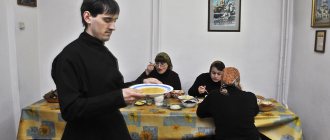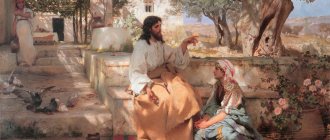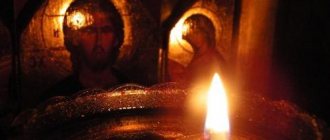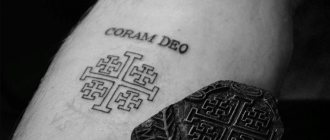“Every church holiday has its own scarf!” - Women, reading this line, will be scared. A year consists of 365 days, which means the same number of hats is needed?
In fact, pious persons may have up to seven scarves in stock. The colors are divided into groups of certain holidays.
About the tradition of wearing a headscarf
In church, sometimes you have to deal with negative attitudes from parishioners towards women without headscarves. The tradition of wearing a headdress originated during the time of the Apostle Paul. A faithful disciple of Christ spoke about the need to cover the heads of married women. A scarf, and in earlier times a veil, a symbol of acceptance of a man’s power, submission to his will. But the first Christian women interpreted these words somewhat differently. Women went out into the street with their heads covered, as required by the rules of decency of that time. The husband could divorce his wife who dared to appear in public without a headdress, deprive her of her dowry and drive her away. In the circle of their family and at divine services, married people sported bare hair (with the permission of their spouse).
As for the family - it’s clear, the husband allows it and all that... And what about Divine services? The fact is that the community was considered a second family. And what embarrassment can there be among one’s own people? So Christian women took off the veil from their heads when they came to joint prayer. Women gave reason for gossip to those who hated Christianity and reported on its followers. Evil tongues spoke about the depraved behavior of ladies who allowed themselves to remove their headdresses behind the closed doors of houses of worship.
The gossip reached the Apostle Paul. The disciple of Christ understood that such behavior of Orthodox Christian women is not good. And then the apostle said:
“Every man who prays or prophesies with his head covered disgraces his head. And every woman who prays or prophesies with her head uncovered disgraces her own head” - First Epistle to the Corinthians.
After the words of the Apostle Paul, the first Christian women stopped their practice. And looking at them, the tradition was continued from century to century by other women. In our time, a scarf on the head symbolizes humility and submission to our Lord Jesus Christ himself. That is why this headdress is worn by little girls, young women and married women.
What should you do on Radonitsa at the cemetery?
According to the traditions of pagan holidays, on Radunitsa, people brought gifts to the deities who guarded the peace of the dead. These gods were called Radovalki and Mogilki. After people gave them food at the cemetery, they went home.
There they set the table, commemorated the dead, and on the street, when meeting beggars, they gave them gifts and treats. Thus, it is believed that once living family members are not forgotten, and their souls are still revered.
The tradition has survived to this day. You must bring boiled eggs with you to the cemetery for the memorial. Break one egg on the cross. Scatter the peelings on the ground and give the insides to the poor.
At the grave, it is allowed to remember the deceased with food, but not to turn it into a large-scale celebration. You can also invite a clergyman to read the funeral prayer. It is better to move the rest of the commemoration to the home table.
If you don’t visit your loved ones in the cemetery, then no one will remember you when your soul goes to another world. Therefore, do not forget traditions and memorable parental days. Just a couple of hours to remember your loved ones will not take up much of your time.
Should modern women wear a headscarf?
Young clergy are sometimes somewhat cool about observing ancient traditions. The most important thing is the salvation of the human soul, the acceptance of the Holy Mysteries of Christ (communion). Everything else is akin to husk. As stated above, the scarf is a symbol of humility before the Lord, a small sacrifice to the Savior for what He has done for the human race.
Why sacrifice? The fact is that wearing a headscarf, especially in summer, is still a pleasure. You have to endure the heat, your head sweats, your scarf sticks to your forehead and cheeks. There is little pleasant, but Orthodox Christian women stoically endure the inconvenience.
We, unlike the first followers of Christ, are not able to perform such feats as they did. So we offer small sacrifices to the Lord as gratitude for His love and mercy towards us.
About the colors of scarves
The robes of clergy depend on certain holidays. When festivities are dedicated to the Savior, the clergy wear white vestments, and parishioners wear scarves of the same color. Christian women tie blue scarves on the feast days of the Blessed Virgin Mary, and yellow scarves on Sunday services. Once you look closely, it becomes clear that all the colors of the rainbow are present in ceremonial, church attire (in the literal sense of the word): blue, yellow and their shades, green, purple, red.
Pious women, gathering for a festive service, wear a scarf of a certain color. Let's talk more about this.
Funeral notes and litias
Let us clarify for readers who may not be aware of what kind of notes are given in churches for Radonitsa: among parishioners, before the start of the service, it is customary to leave leaves in the church shop with the names of deceased relatives and friends, which will then be given to the priest.
The note submitted is not half as valuable without our sincere prayers.
However, people who go home with a clear conscience after this will do wrong. The custom of notes was created not so much for the dead - God does not need to remind them, He remembers everyone - but for us. Those who, having lost the joy of communicating with a loved one, yearn for him, but in the bustle of everyday life do not find time to think about the deceased without haste: remember his speeches and actions, pray with words from the depths of his heart, feel the former closeness. Common prayer in church allows you to do all of the above, but the responsibility shifted to the priest to formally voice dry names that mean nothing to him deprives this joy.
The prayers that are ordered for Radonitsa in the church also include litias - special memorial services that the priest serves at the graves after the funeral service. It is necessary to agree on them before the holiday - the priest is not omnipotent and is unlikely to be able to pay attention to everyone on the special day.
White scarf
White color in Orthodoxy is a symbol of triumph and joy. When the Lord rose from the dead, he appeared to the disciples in a “blaze of glory”—in white robes.
“Christ is risen from the dead, trampling down death by death and giving life to those in the tombs” - triumph and rejoice, Orthodox!
Women can wear white scarves at Easter Services, Sunday services (Resurrection - Little Easter), and other holidays dedicated to the Savior. This is Christmas, Epiphany, Ascension, Transfiguration.
When going to a baptism or wedding, a white headdress is desirable.
Let's touch on another, rather painful topic. When coming to church for a funeral service, Christian women wear black scarves. Meanwhile, the clergy performs the rite, wearing white vestments. Death is the transition from earthly life to eternal life. This is a joy for the deceased, if he lived a Christian life, a long-awaited meeting with the Savior. People who have lost a loved one grieve, they are in mourning, this state is expressed by wearing black clothes and a scarf.
Temple scarf PTK180006
1 600 ₽
The scarf for the temple is made of white lace fabric, edged with lace in the color of the main fabric.
Shawl cape for temple PTK180010
1 800 ₽
The temple scarf is made of white lace fabric, edged with wide lace in the color of the main fabric.
Temple scarf PTK180015
1 550 ₽
Temple scarf made of delicate milky chiffon. The edge is edged with lace in the color of the main fabric.
Scarf snood for the temple SND180021
1 200 ₽
Scarf-snood for the temple made of white chiffon, trimmed with delicate lace along the edge.
Scarf snood for the temple SND180025
1 100 ₽
Scarf-snood for the temple made of milky chiffon, edged with woven lace.
Scarf snood for the temple SND190031
1 650 ₽
A delicate white snood scarf made of lace fabric with floral patterns.
Kerchief KOS190039
650 ₽
The scarf is made of delicate white chiffon
Temple scarf PTK190045
1 750 ₽
The temple scarf is made of white lace fabric, edged with woven lace in the color of the main fabric.
Temple scarf PTK190046
1 200 ₽
The temple scarf is made of delicate white chiffon, edged with lace on a mesh in the color of the main fabric.
Temple scarf PTK190048
1 300 ₽
The temple scarf is made of delicate white chiffon, edged with guipure lace in the color of the main fabric.
Temple scarf PTK190049
1 500 ₽
The temple scarf is made of delicate white chiffon, edged with woven lace in the color of the main fabric.
Is Radonitsa a day off?
Radunitsa is celebrated on St. Thomas Week on Tuesday. This is a working day unless it falls on a calendar holiday on which it is not customary to work. But, despite this, in churches at the end of the evening service or after the liturgy, a memorial service is held. It happens in a special way. Easter songs are sung that speak of joy and eternal life.
“Let us try, as much as possible, to help the departed, instead of tears, instead of sobs, instead of magnificent tombs - with our prayers, alms and offerings for them, so that, in this way, both they and we will receive the promised benefits,” writes St. John Chrysostom.
Red color
The Easter service continues, the clergy change into red vestments. Red color is a symbol of God’s unearthly love for a sinful world. The God-man came to earth, incarnated in a “most honest, pure and virgin womb” in order to save the human race. The Savior shed his own Blood, voluntarily entering the cross, accepting the most shameful death of that time.
Together with love, the red color is the Blood of Christ, shed for us. And this also includes the blood of martyrs - a reminder of a terrible death for the sake of the Lord. That is why on the days of their memory and for 50 days until the Ascension, the color of the clergy’s clothing is red. Women should choose a scarf of this color or white.
Temple scarf PTK190033
2 100 ₽
The red temple scarf is made of lace fabric, edged with guipure lace in the color of the main fabric.
Temple scarf PTK190043
1 200 ₽
The temple scarf is made of delicate red chiffon, edged with woven lace along the front.
Temple scarf PTK190044
1 800 ₽
The red temple scarf is made of lace fabric, the front part is edged with guipure lace in the color of the main fabric.
Scarf snood for the temple SND190047
900 ₽
A one-turn snood scarf allows you to cover your head and shoulders. Made of red chiffon, edged with woven lace.
Green - Trinity
Green color is associated with the holiday of Trinity and Spiritual Day. These days, churches are decorated with young birch trees and grass, and there is a tart smell of greenery. Believers bring birch branches for consecration, priests are dressed in green vestments.
Trinity or Pentecost is the birthday of the modern Church. In the Old Testament, it was an agricultural holiday; thanksgiving was offered to God for the first harvest. After the Resurrection of Christ, the holiday of the Trinity took on a different meaning. On this day there was a descent of the Spirit of God on the Apostles. And the disciples of Christ spoke in different languages, and the people who witnessed this miracle were amazed at what was happening. Some accused the Apostles of drinking too much wine, hence the strangeness of their speech. But witnesses came to their defense, talking about what happened. The gospel must be preached throughout the world, in all languages - and so the prophecy was fulfilled.
The Apostle Paul preached a sermon that day, after which more than 3 thousand people were baptized. Thus was born the New Testament Church.
Green color is obtained by mixing blue and yellow. The Lord came to earth to open the way to the Kingdom of Heaven for humanity. With the help of Communion, a person is united with Christ, ascending to heaven (in a figurative sense).
That is why Orthodox Christian women tie a green scarf on these holidays.
Shawl for church PTK180012
1 200 ₽
The church scarf is made of delicate powder-mint chiffon, edged with lace in the color of the main fabric.
Temple scarf PTK180018
1 100 ₽
The temple scarf is made of delicate chiffon in a powdery mint color, edged with satin bias tape in the color of the main fabric.
Scarf snood for the temple SND180022
1 300 ₽
Temple scarf made of chiffon in a powdery-mint color, trimmed with delicate lace along the edge.
Temple scarf PTK190034
1 800 ₽
The temple scarf is made of rich green lace fabric. The edge is edged with lace in the color of the main fabric.
Temple scarf PTK190053
800 ₽
Temple scarf made of sparse chiffon in a powdery mint color. The edge is edged with satin bias tape, and the front part is trimmed with guipure lace.
Church opinion
The Bible texts regarding the culture of behavior and clothing within the walls of the temple should be interpreted according to the time and traditions of a particular country. Believers must wear clothing in church that does not discredit the Christian faith.
There is no detailed teaching on the need for headdress in the temple. Ministers of different Orthodox churches interpret in their own way the texts of the Holy Scriptures, written in an ancient language. The words “shame” and “glory” that the Apostle Paul uses in his verses have their own cultural characteristics in different countries.
In Greece, Orthodox believers of any gender visit churches and pray to the Lord without covering their heads. This tradition appeared during the Turkish invasion of the country. Muslims forced the female population of the country to wear a hijab in all public places - a veil that covers the head and most of the figure.
Greeks who converted to Christianity protested against forced Islamization. Temples were visited at night. Upon entry, hats were removed as a matter of principle. This tradition is over 200 years old. Modern Greek women do not cover their heads in churches; church ministers do not recognize this as a violation of religious rules.
Orthodox Russia has developed its own historical traditions. Starting from the 15th century, their formation was influenced by the Domostroy collection. It contained instructions concerning rules, mainly religious and family. According to Domostroy, a woman’s head covered with a scarf symbolizes humility, modesty, and the wife’s subordination to her husband. According to the traditions of those times, both married and unmarried women were required to cover their heads with a scarf when entering the church.
Modern women have equal rights with men in society and family. The headscarf, as a symbol of submission, has lost its relevance. Church ministers do not insist on head covering. The believers themselves preserve ancient Christian traditions, monitor their implementation, and instill them in their children. Even little girls are tied with a headscarf when entering the temple.
Purple – memories of suffering
The clergy uses this color of vestments on the Feast of the Exaltation, on the Week of the Cross during Lent and its Sunday services. The color purple is a symbol of the suffering of the Lord.
The Savior's ascension to the cross opened the way to the Kingdom of Heaven. Before the Lord was born of the Virgin Mary and sacrificed Himself for the human race, sinners and righteous people went to hell. This is due to the fall of the first people, their apostasy, for which their descendants paid. The Savior's death on the cross divided the Old and New Testaments.
Purple color is obtained by mixing red and blue. The colors of Purity and Blood were united in memory of the price at which the salvation of the human race was achieved. What Jesus Christ did for this, and how the Virgin Mary suffered, looking at her Son, crucified “for us under Pontius Pilate.”
Women wear a purple scarf on these holidays, in memory of the suffering of the Savior.
Scarf snood for the temple SND180026
1 400 ₽
The temple scarf is made of light lilac chiffon, trimmed along the edge with delicate lace to match the main fabric.
Scarf snood for the temple SND190036
1 100 ₽
The snood scarf is made of delicate purple chiffon, trimmed with thin lace along the edge.
Black scarf
In divine services, black is used during Lent and at funeral services. Dressing in black vestments entered church practice only in 1730, when the clergy were invited to dress in them for the burial of Peter I.
Black color is a symbol of sorrow and repentance. It is no coincidence that monastic vestments are exactly like this. This is withdrawal from the world, avoidance of vanity, devotion to repentant meditation, grief over one’s sins.
A black scarf is worn during mourning, both church and personal.
Scarf snood for the temple SND200061
1 500 ₽
A delicate black snood scarf, made of guipure with floral patterns.
Scarf snood for the temple SND200063
1 300 ₽
The snood scarf is made of brown chiffon, trimmed with delicate lace along the edge.
Scarf snood for the temple SND180029
1 300 ₽
The temple scarf is made of black chiffon, edged with lace to match the main fabric.











